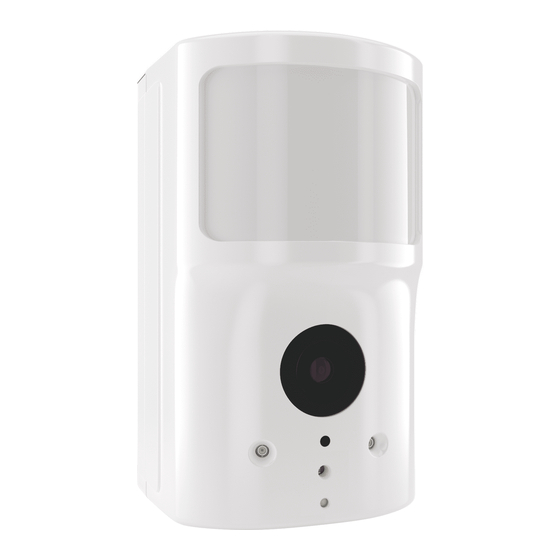
Table of Contents
Advertisement
Quick Links
DSC PowerSeries Neo Image Sensor Installation Guide - ADC-
IS-300-LP
PRODUCT SUMMARY & TECHNICAL SPECIFICATIONS
The Image Sensor is a pet immune PIR (passive infrared) motion detector with a built-in camera designed to capture
images during alarm or non-alarm events when motion is detected.
Product Features:
• Communicates wirelessly to the security control panel
• 35 foot detection range with a 90 degree horizontal FOV
• Configurable PIR sensitivity and pet immunity settings
• Image: VGA 640x480 pixels
• Color Images (except in night vision)
• Night vision image capture with infrared flash (black & white)
• Tamper detection, walk test mode, supervision
• All systems can support up to three Image Sensors
• UL 639 certified
Technical Specifications:
• Alarm.com Model Number: ADC-IS-300-LP
• Interlogix Part Numbers:
• Power Source: Recommended 2 AA 1.5v Energizer Ultimate Lithium Batteries.
https://answers.alarm.com/Installation_and_Troubleshooting/Image_Sensor/DSC_PowerSeries_Neo_Image_Sensor/DSC_PowerSeries_
Updated: Tue, 17 Apr 2018 13:46:31 GMT
1
Advertisement
Table of Contents

Summary of Contents for DSC ADC-IS-300-LP
- Page 1 DSC PowerSeries Neo Image Sensor Installation Guide - ADC- IS-300-LP PRODUCT SUMMARY & TECHNICAL SPECIFICATIONS The Image Sensor is a pet immune PIR (passive infrared) motion detector with a built-in camera designed to capture images during alarm or non-alarm events when motion is detected.
-
Page 2: Hardware Compatibility Requirements - By Panel
• Batteries: Refer to the Batteries section for details • Operating Temperature Range: 60° to 80°F • Weight: 3.1 oz. (with batteries and without mounting accessories) • Dimensions: 3.1’’ h x 1.8’’ w x 2.3’’ d • Supervisory Interval: 100 minutes (sensor), 3 hours (alarm hardwire) •... -
Page 3: Camera Led Reference Chart
Replacing batteries: To replace the sensor batteries, slide the front of the sensor up off the sensor-back. Dispose of used batteries per the battery manufacturer instructions and following local regulations. CAMERA LED REFERENCE CHART Camera LED Chart: Refer to this chart to understand the camera LED patterns. https://answers.alarm.com/Installation_and_Troubleshooting/Image_Sensor/DSC_PowerSeries_Neo_Image_Sensor/DSC_PowerSeries_ Updated: Tue, 17 Apr 2018 13:46:31 GMT... - Page 4 https://answers.alarm.com/Installation_and_Troubleshooting/Image_Sensor/DSC_PowerSeries_Neo_Image_Sensor/DSC_PowerSeries_ Updated: Tue, 17 Apr 2018 13:46:31 GMT...
-
Page 5: Resetting The Image Sensor
RESETTING THE IMAGE SENSOR There are two ways to reset the Image Sensor: • Power Cycle – Power Cycle can be done by one of two ways: (1) Take out and reinsert batteries or (2) press and release the sensor reset button. Only initiate a power cycle if the LED has not been active in the last 10 seconds. After a power cycle, the Image Sensor will enter sensor power up state followed by the memory check state. -
Page 6: Service Plans Requirements
yellow after the memory check (solid red LED). A network reset will only work if the Image Sensor is not actively communicating with a network. If the Image Sensor is within range of the original panel, it is required that the Image Sensor first be deleted from the panel it was previously learned into before being able to perform a network reset on the Image Sensor. -
Page 7: Installation: Preparing Panel For Enrollment
INSTALLATION: ENROLLING IMAGE SENSOR TO PANEL Daughterboard required for Rev6.0 (ADC-600T). No daughterboard required for Rev6.2 (ADC-620T). DSC Impassa and PowerSeries Neo 1. Verify there is Image Sensor Daughterboard Installed. Compatible communicators are identified with an “I” as part of the model number. List of compatible communicators with Image Sensor daughterboard pre-installed: 3G8055(I), CD8055(I), 3G8080(I), or CD8080(I). -
Page 8: Installation: Mounting Image Sensor
INSTALLATION: MOUNTING IMAGE SENSOR 1. Determine the desired mounting angle – 3 options 2. Screw bracket to back plate. https://answers.alarm.com/Installation_and_Troubleshooting/Image_Sensor/DSC_PowerSeries_Neo_Image_Sensor/DSC_PowerSeries_ Updated: Tue, 17 Apr 2018 13:46:31 GMT... - Page 9 3. Determine location to mount sensor. 4. Choose applicable mounting bracket. The sensor hardware packet contains two mounting brackets for different mounting scenarios. Use the provided large screws and anchors to attach the bracket to the wall. (Leave at least 3 inches of clearance above the sensor to allow for battery replacement without uninstalling the mounting https://answers.alarm.com/Installation_and_Troubleshooting/Image_Sensor/DSC_PowerSeries_Neo_Image_Sensor/DSC_PowerSeries_ Updated: Tue, 17 Apr 2018 13:46:31 GMT...
- Page 10 bracket.) 5. Place sensor with arm on mounting bracket. Adjust the horizontal positioning of the sensor to point towards the desired coverage area. 6. Secure the mounting arm location by sliding lock pin into the hole. Use the washer and remaining small screw to secure the lock pin by screwing upwards through the bottom of the hole in the mounting bracket.
-
Page 11: Deleting Image Sensor From Panel
1. Verify that rules are confirmed via the dealersite or on MobileTech, Resend rules if they are not confirmed. 2. Verify RF Coverage by checking that the signal strength is above 40%. The signal strength must be greater than 30% for sensor to function properly. 3. -
Page 12: General Troubleshooting Steps
Figure 4.Top View: PIR Lens Coverage As indicated in Figure 4, the camera coverage area is narrower than the PIR coverage area. When installing, mount sensor where subjects are likely to be centered in or across PIR and camera field of view. TROUBLESHOOTING General Troubleshooting Steps •... -
Page 13: False Motion Activations
sensor closer to control panel, verify signal strength and see if communication resumes. Be sure that Image Sensor daughterboard antenna is correctly routed as indicated in step 5 of the installation procedure. • Replace Batteries: Check battery level at the panel (under “Image Sensor Settings”) and install fresh sensor batteries.













Need help?
Do you have a question about the ADC-IS-300-LP and is the answer not in the manual?
Questions and answers